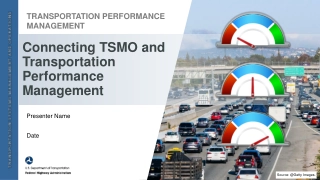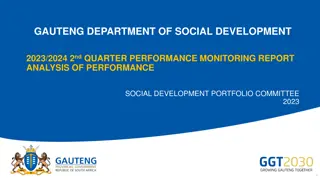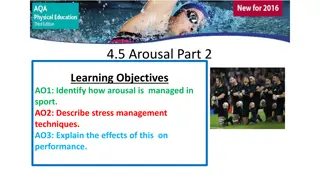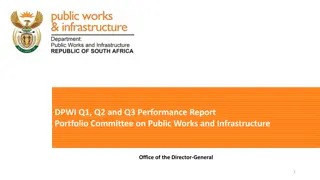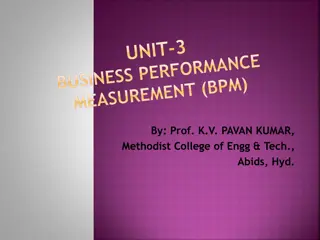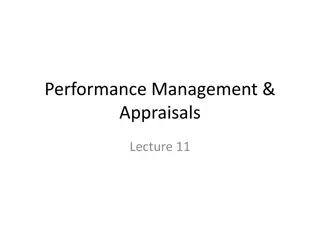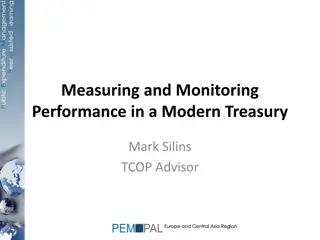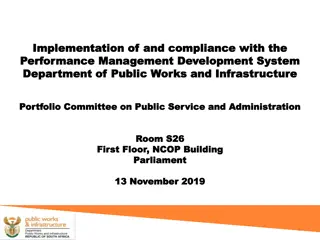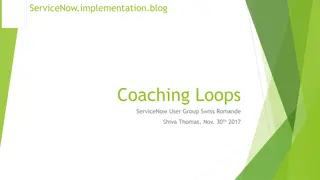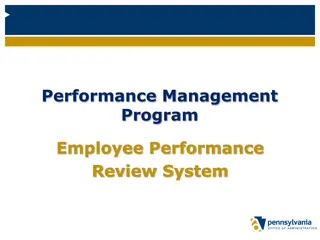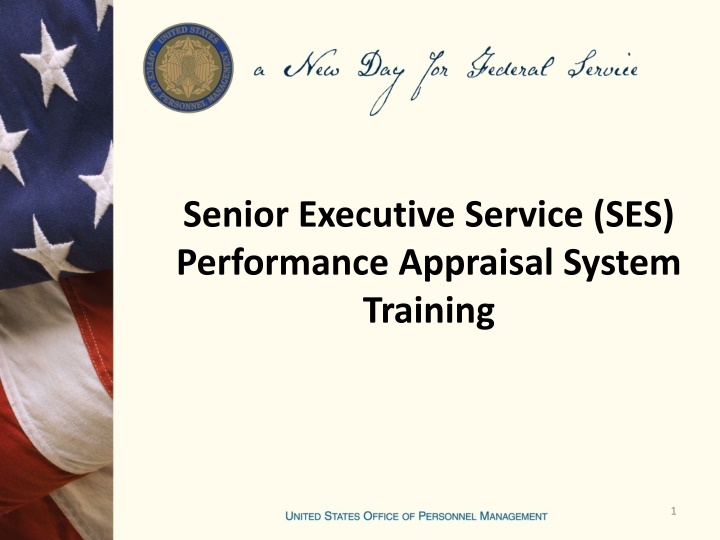
SES Performance Appraisal System
Explore the comprehensive SES Performance Appraisal System designed to ensure consistency, clarity, and equity in evaluating Senior Executive Service members based on Executive Core Qualifications. Learn about the background, principles, and benefits of this interagency-developed system for effective executive performance management.
Uploaded on | 0 Views
Download Presentation

Please find below an Image/Link to download the presentation.
The content on the website is provided AS IS for your information and personal use only. It may not be sold, licensed, or shared on other websites without obtaining consent from the author. If you encounter any issues during the download, it is possible that the publisher has removed the file from their server.
You are allowed to download the files provided on this website for personal or commercial use, subject to the condition that they are used lawfully. All files are the property of their respective owners.
The content on the website is provided AS IS for your information and personal use only. It may not be sold, licensed, or shared on other websites without obtaining consent from the author.
E N D
Presentation Transcript
Senior Executive Service (SES) Performance Appraisal System Training 1
Background ECQ-Based SES Performance Appraisal System The interagency-designed basic SES appraisal system provides for the uniform administration of executive performance management systems within the Federal Government by promoting consistency, clarity, and transferability of performance processes, standards, feedback, and ratings across agencies, and Being rooted in the Executive Core Qualifications (ECQs) that enable a lifecycle approach to managing the Executive cadre a balanced emphasis on strategic leadership and results enhanced equity and mobility of SES members within and across agencies greater flexibility for agencies to develop performance metrics 3
A Basic SES Performance Appraisal System In 2011, a workgroup created through the President s Management Council SES Initiative recommended the design of a standard SES Appraisal System. A broad and diverse group of Federal agencies and organizations collaborated to develop a single performance appraisal system applicable to all organizations and their SES members. OPM also consulted with a broad group of stakeholders throughout the process to ensure the new system incorporates leading practices and reflects all interests and needs, including: the President s Management Advisory Board; SES members; and the Senior Executives Association. 4
Guiding Principles and Foundational Benefits Guiding Principles Foundational Benefits to SES Consistency Created with a common language; promotes consistent evaluations across agencies Integrity Developed with Governmentwide collaboration and agreement Fairness Promotes equitable evaluation across Government Leadership-Focused SES members are accountable for demonstrating executive-level leadership, using the Executive Core Qualifications (ECQs) as a basis. 5
Guiding Principles and Foundational Benefits Guiding Principles Foundational Benefits to SES Clarity Facilitates a clearer path to full certification Flexibility Agencies can customize performance metrics while maintaining the system s overall consistency Best Demonstrated Practice Informed by best practices 6
What Are the Major Improvements Provided by the SES Appraisal System? Key Features of the Basic SES Appraisal System Previous Approach 1. Wide range of performance elements and definitions across agencies Five performance elements based on the five ECQs, with Governmentwide performance requirements. DoD will use a sixth as well. 2. Mix of four- and five- level rating systems, inconsistent derivation formulas Five-level rating system in all agencies Established performance standards for each rating level Standard numerical rating derivation formula 3. Varying emphasis on leadership competencies Minimum weighting for all ECQs, ensuring accountability for demonstrating leadership skills 7
What Are the Major Improvements Provided by the SES Appraisal System? Key Features of the Basic SES Appraisal System Previous Approach 4. Wide disparity in distribution of ratings by agency Clear, descriptive performance standards and rating score ranges that establish mid-level ratings as the norm and top- level ratings as truly exceptional 5. Different agency appraisal forms, complicating mobility and cross-Govt. comparisons Standard performance appraisal form with flexibility for limited customization by agencies 6. No requirement for summary narrative to explain ratings Mandatory summary rating narrative, promoting richer feedback for SES 8
How Does the New System Affect You? Feature of the New SES Appraisal System How Change May Affect How You Do Performance Management 1. Six standardized performance elements Old performance elements and competencies fit well under new elements, so you can still use similar standards. (See Crosswalk Handout) 2. Five-level rating system & standardized derivation formula All SES will be rated on the same five- level system. 3. Minimum weighting for all ECQs Minimum weighting still allows customizability, as agencies will still be able to adjust weightings to correlate with their respective missions. 9
How Does the New System Affect You? Feature of the New SES Appraisal System How Change May Affect How You Do Performance Management 4. Normalized rating distributions Makes executive ratings and awards more fair. 5. Standard performance appraisal form with flexibility Most of you use EPAT, and it will be adjusted to capture what is required, while a few others will use the new standardized form 6. Mandatory summary rating Potentially more work for rating officials, but better feedback for SES. 10
Training Objectives After completing this training, you will Understand the key Performance Management Processes. Understand, within the new system, how to write and use your Performance Plan Understand the importance of Performance Feedback. Understand requirements for Executive Development. Understand, within the new system, how Summary Ratings are Derived. 11
SECTION 1: Performance Management Processes Overview 12
Section 1 Objectives After completing this lesson, you will be able to Describe the five key processes of performance management. Describe the associated time frames of the performance management process. 13
Key Performance Management Processes Planning Performance Monitoring Performance Rewarding Performance Developing Performance Rating Performance 14
Performance Management Process Timelines Appraisal Period: October 1 through September 30 Minimum Period: 90 days. Approve Performance Plan: on or before the first day of the appraisal period. Progress Review: roughly at the midpoint of the appraisal period. Initial Summary Rating: within one month of the closing of the appraisal period. Final Annual Rating PRB rating 15
SECTION 2: Planning Performance 16
Planning Performance Planning Performance Monitoring Performance Rewarding Performance Developing Performance Rating Performance 17
Section 2 Objectives After completing this lesson, you will be able to Describe the criteria for senior executive performance plans: critical elements, performance requirements, and performance standards. Align performance requirements with agency goals. Distinguish between activities and results. Develop a performance plan by writing measurable, results-focused performance requirements. 18
Planning Performance Three important aspects to planning performance include - 1. Link performance plan to organizational goals. 2. Develop Results Driven performance requirements. 3. Consult with executives on the development of their performance plans. 19
Align and Plan Work Performance plans must clearly link to: Presidential Orders and Initiatives Mission Statements Strategic Plans Organizational Goals Budgetary Priorities Get these documents in front of you when you write your plans. 20
Develop the Performance Plan Overview Critical Elements Performance Requirements Applying the basic Performance Standards Developing the Results-Driven Requirements 21
Develop the Performance Plan Definitions Activities-actions taken to produce results. Competencies- the personal and professional attributes that are critical to successful performance in the SES. Critical element-a key component of an executive s work that contributes to organizational goals and results and is so important that unsatisfactory performance of the element would make the executive s overall job performance Unsatisfactory. Outcome -describes the intended result or consequence that will occur from carrying out a program or activity. .22
Develop the Performance Plan Definitions (cont d) Outputs-goods and services produced by a program or organization and provided to the public or to other programs or organizations. Performance requirements- statement of the performance expected for a critical element. Performance standards- the description of performance expected at a given level of performance. Result-Consequence(s) of activities, accomplishments and outputs (can be short term, annual or long term). 23
Develop the Performance Plan Critical Elements Critical elements-components of an executive s work that contribute to the accomplishment of organizational goals and results. Unsatisfactory performance in one or more of the five critical elements results in overall Unsatisfactory (Level 1) performance. 24
Develop the Performance Plan Critical Elements The five critical elements are based on the Executive Core Qualifications (ECQs) Leading Change. Leading People. Business Acumen. Building Coalitions. Results Driven. 25
Develop the Performance Plan Weighting Critical Elements The basic SES appraisal system description requires that all critical elements be weighted. Results Driven = at least 20%. All other Critical Elements = at least 5%. No single critical element can weigh more than the Results Driven element. Sum of the weights = 100%. 26
Develop the Performance Plan Weighting Critical Elements How will the Department of Defense weight the critical elements? The Secretary of Defense may determine the weights annually. The system gives flexibility to agencies. Officials have not made final decision yet. 27
Develop the Performance Plan Performance Requirements The basic SES appraisal system description has language addressing Governmentwide performance requirements for all critical elements except the Results Driven critical element. 28
Develop the Performance Plan Performance Requirements The basic system s performance requirements comply with regulations for system approval and certification and include - Balanced measures of customer and employee perspectives. Accountability for the performance management of subordinates, including alignment of performance plans. 29
Develop the Performance Plan Performance Standards The basic SES appraisal system establishes performance standards for each performance level and are part of the performance plan. The performance requirements and standards are used together to rate executive performance. 30
Develop the Performance Plan Results Driven Element Executives must develop the performance requirements for their Results Driven element that are clearly linked to organizational goals. The Results Driven performance requirements must be comprised of measurable results. Results Driven performance requirements can be stated as either outcomes or outputs. Outcomes are more meaningful (to customers, stakeholders and the public) than outputs, which tend to be more process-oriented or means to an end. 31
Develop the Performance Plan Results Driven Element Agency or Governmentwide performance results are found in Presidential Orders and Initiatives. Agency High Priority Goals. Strategic Plans. Organizational Goals. Budgetary Priorities. 32
Develop the Performance Plan Alignment of Results Driven Element Strategic Goals/Governmentwide Goals Annual Goals/Agency Priority Goals (Near term) Optimized Customer Engagement Annual customer satisfaction rating Outputs (Short Term goals) Customer feedback collected to inform strategy Increased Financial Capability Projects on time/on budget Achieve 30% cost savings 33
Develop the Performance Plan Results Driven Element Everyday Example U N H E A L T H Y New Join a health club knowledge and different practices Improved Health Outcome Interim result Activity (final result) Situation 34
Develop the Performance Plan Results Driven Element Agency Example Decreased application processing time by 40% Implement action plan to Decrease Time to Hire Customers Satisfied with Agency Time to Hire Decrease the time to hire Annual Goal/High Priority goal (Interim result) Activity Agency Goal Strategic Goal (Outcome) 35
Develop the Performance Plan Results Driven Element Results Driven performance requirements must include credible measures with targets of performance. Performance measures are the indicators or metrics that are used to gauge program performance. Performance measures can either be output or outcome measures. 36
Develop the Performance Plan Results Driven Element General measures include Quantity Quality Timeliness and/or Cost-Effectiveness 37
Develop the Performance Plan Results Driven Measures Effective performance measures can indicate How well the executive is doing. If the executive is meeting goals. If customers are satisfied. If processes are within statistical controls. If and where improvements are needed. 38
Develop the Performance Plan Results Driven Measures Quantity Number of products or services provided, or a production quota to be met, or percent to be achieved. Consider the customer/stakeholder needs for numbers achieved or produced. Examples Backlog reduced by 50-55% An average of 100 cases resolved per month over the year A 60-75% increase in stakeholder use The percentage of lead in the water is reduced by 10-15% 39
Develop the Performance Plan Results Driven Measures Quality Addresses the level of excellence of the achievement, to include accuracy , appearance, customer satisfaction, relevance, usefulness, functionality, and/or effectiveness. Consider whether the customer/stakeholder cares about the quality of the result. Examples The agency has a 95-97% accuracy rate in case completion Program policy supports the Administration s initiative Policy incorporates stakeholder feedback 70-80% customer satisfaction rate with agency service 40
Develop the Performance Plan: Results Driven Measures Timeliness Timeframe or deadline for the result. Consider whether customers/stakeholders care when a result is achieved. Consider whether it is important to accomplish a result by a certain time or date. Examples Result achieved by June 1 Project meets quarterly milestones 41
Develop the Performance Plan Results Driven Measures Cost-Effectiveness How much savings or cost controls. Important for Government accountability. Must be able to document and measure. Consider whether it is important to complete work or produce results within certain cost constraints. Examples Reduced expenses by 1-3%, maintaining quality Reduced waste by at least 5%, maintaining quality Completed project within 5% of budget, without exceeding budget 42
Develop the Performance Plan Results Driven Measures For each result identified for the Results Driven element (output and/or outcome), ask How can the [quantity, quality, timeliness, or cost- effectiveness] of the result be measured? Is there a number or percent that can be tracked? If not, who can determine that the performance result met expectations and what are the factors that person would look for? Pre-determined agency High Priority and Strategic Goals can help answer these questions. 43
Develop the Performance Plan Results Driven Measures If the measure is more descriptive than numeric, the performance result should include Person or group that could judge performance. E.g. customers, stakeholders, supervisor. Factors that the judge would expect in performance. What the judge can observe and report to verify the performance level achieved. 44
Develop the Performance Plan Results Driven Measures Key points when developing performance requirements for the Results Driven element: DON T list tasks and activities (e.g., hold five meetings; visit eight field locations). DO identify the desired outputs, outcomes. If you re having difficulty turning an activity into a measureable output or outcome, try this trick to getting your thoughts moving in the right direction Just fill in the blanks in the following: I will _(do what?)___ by _(when?) resulting in _______________, and my success can be verified using _____________. 45
Develop the Performance Plan Results Driven Element Pitfalls to Avoid Focusing on processes Focus on more than process (operational) data. Focus on the longer-term measures of customer satisfaction, employee satisfaction, product/service quality, and public responsibility. Failing to base business decisions on the data You have the data so use it. Dumbing down the data - Sometimes data can be summarized so much that it becomes meaningless. If business decisions are going to be based on the data, then the data needs to be meaningful and useful. 46
Develop the Performance Plan Results Driven Element Writing Requirements and Guidance Measurable standards must be written at the fully successful level. Avoid writing standards that have no room to exceed expectations. In addition, for each measure OPM and DoD suggest: Developing stretch goals (what does performance look like at the outstanding level) Developing a description of what minimally successful performance would look like so that executives have a better idea when their performance dips to that level. 47
Quality Check the Performance Plan Results Driven Element S.M.A.R.T. Framework Performance Measures should be: Specific Measurable Aligned Realistic Timeframe-bound 48
Develop the Performance Plan Results Driven Measures Performance measure example from the past: Benefits to national defense and security by achieving 85% percent of planned technology transitions. 49
Develop the Performance Plan Results Driven Measures Performance measure example from the past: Attends all team meetings as needed. 50


